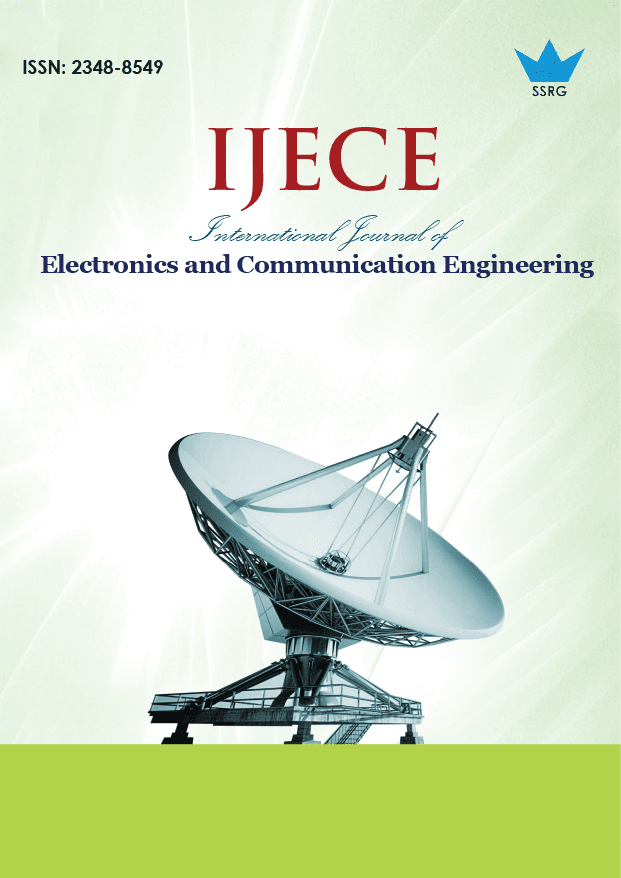Semi-Supervised Fault Prediction and Proactive Task Migration in Dynamic Edge Environments using PreGAN+

| International Journal of Electronics and Communication Engineering |
| © 2025 by SSRG - IJECE Journal |
| Volume 12 Issue 10 |
| Year of Publication : 2025 |
| Authors : Sarala Patchala, Banda S N V Ramana Murthy, Vijaya Babu Burra, Shaik Jameer, Vullam Naga Gopiraju, Inakoti Ramesh Raja |
How to Cite?
Sarala Patchala, Banda S N V Ramana Murthy, Vijaya Babu Burra, Shaik Jameer, Vullam Naga Gopiraju, Inakoti Ramesh Raja, "Semi-Supervised Fault Prediction and Proactive Task Migration in Dynamic Edge Environments using PreGAN+," SSRG International Journal of Electronics and Communication Engineering, vol. 12, no. 10, pp. 50-63, 2025. Crossref, https://doi.org/10.14445/23488549/IJECE-V12I10P106
Abstract:
Mobile Edge Computing (MEC) systems operate at the network's edge. They use resource-constrained devices. These systems face challenges due to limited computing power. Frequent faults occur due to high workloads and system failures. To address this, fault-tolerant approaches help maintain system stability. One common method is pre-emptive migration. It transfers active tasks from overloaded nodes to available ones. However, existing approaches struggle to adapt to unpredictable workloads. Many fail to detect anomalies accurately. This leads to inefficient resource utilization and system failures. PreGAN+ is a machine learning-based fault prediction model. It uses Generative Adversarial Networks (GANs) to detect faults. GANs model complex distributions and predict faults accurately. PreGAN+ also identifies which resource type (CPU, memory, or disk) is to fail. The model achieves quick adaptation to dynamic environments. It minimizes unnecessary migrations by focusing only on critical tasks. PreGAN consists of two parts. The first part is a neural network-based fault classifier. It uses a few-shot learning method for accurate classification. The second part is a GAN-based decision model. This component generates optimal migration decisions. PreGAN uses coupled simulations to train its GAN model. The system continuously updates its fault classification decisions. PreGAN+ extends the original PreGAN model. It introduces a semi-supervised learning method. This method fine-tunes the decision model using limited labeled data. The updated model uses a Transformer-based neural network. This improves tuning speed and accuracy. However, it also increases memory usage. The research highlights the advantages of using GANs for predictive modeling. The study confirms that semi-supervised learning improves adaptability in dynamic environments. PreGAN+ provides an effective solution for fault-tolerant computing in MEC systems. It results in higher Quality of Service (QoS) while optimizing resource utilization. The model is highly beneficial for environments with frequent workload fluctuations.
Keywords:
Fault prediction, GAN, Mobile edge computing, Pre-GAN, Quality of Service.
References:
[1] Rafia Malik, and Mai Vu, “Energy-Efficient Computation Offloading in Delay-Constrained Massive MIMO Enabled Edge Network using Data Partitioning,” IEEE Transactions on Wireless Communications, vol. 19, no. 10, pp. 6977-6991, 2020.
[CrossRef] [Google Scholar] [Publisher Link]
[2] Latif U. Khan et al., “Edge-Computing-Enabled Smart Cities: A Comprehensive Survey,” IEEE Internet of Things Journal, vol. 7, no. 10, pp. 10200-10232, 2020.
[CrossRef] [Google Scholar] [Publisher Link]
[3] Ding Yuan et al., “Simple Testing can Prevent Most Critical Failures: An Analysis of Production Failures in Distributed Data-Intensive Systems,” 11th USENIX Symposium on Operating Systems Design and Implementation (OSDI 14), pp. 249-265, 2014.
[Google Scholar] [Publisher Link]
[4] Hairong Qi et al., “A Resilient Real-Time System Design for a Secure and Reconfigurable Power Grid,” IEEE Transactions on Smart Grid, vol. 2, no. 4, pp. 770-781, 2011.
[CrossRef] [Google Scholar] [Publisher Link]
[5] Yang Yang, Qiang Cao, and Hong Jiang, “Edgedb: An Efficient Time-Series Database for Edge Computing,” IEEE Access, vol. 7, pp. 142295-142307, 2019.
[CrossRef] [Google Scholar] [Publisher Link]
[6] Jinke Ren et al., “Collaborative Cloud and Edge Computing for Latency Minimization,” IEEE Transactions on Vehicular Technology, vol. 68, no. 5, pp. 5031-5044, 2019.
[CrossRef] [Google Scholar] [Publisher Link]
[7] Sheng Di, and Cho-Li Wang, “Dynamic Optimization of Multiattribute Resource Allocation in Self-Organizing Clouds,” IEEE Transactions on parallel and Distributed Systems, vol. 24, no. 3, pp. 464-478, 2012.
[CrossRef] [Google Scholar] [Publisher Link]
[8] Bela Ali, Mark A. Gregory, and Shou Li, “Multi-Access Edge Computing Architecture, Data Security and Privacy: A Review,” IEEE Access, vol. 9, pp. 18706-18721, 2021.
[CrossRef] [Google Scholar] [Publisher Link]
[9] Chi-Yu Li et al., “Transparent AAA Security Design for Low-Latency MEC-Integrated Cellular Networks,” IEEE Transactions on Vehicular Technology, vol. 69, no. 3, pp. 3231-3243, 2020.
[CrossRef] [Google Scholar] [Publisher Link]
[10] Flavin Cristian, “Understanding Fault-Tolerant Distributed Systems,” Communications of the ACM, vol. 34, no. 2, pp. 56-78, 1991.
[CrossRef] [Google Scholar] [Publisher Link]
[11] B. Kumar, A. Verma, and P. Verma, “Optimizing Resource Allocation using Proactive Scaling with Predictive Models and Custom Resources,” Computers and Electrical Engineering, vol. 118, 2024.
[CrossRef] [Google Scholar] [Publisher Link]
[12] Shreshth Tuli, Giuliano Casale, and Nicholas R. Jennings, “PreGAN: Preemptive Migration Prediction Network for Proactive Fault-Tolerant Edge Computing,” IEEE INFOCOM 2022 - IEEE Conference on Computer Communications, London, United Kingdom, pp. 670-679, 2022.
[CrossRef] [Google Scholar] [Publisher Link]
[13] Zexi Chen et al., “PREGAN: Pose Randomization and Estimation for Weakly Paired Image Style Translation,” IEEE Robotics and Automation Letters, vol. 6, no. 2, pp. 2209-2216, 2021.
[CrossRef] [Google Scholar] [Publisher Link]
[14] Rajendra Kumar et al., Immersive Virtual and Augmented Reality in Healthcare: An IoT and Blockchain Perspective, CRC Press, pp. 1-244, 2023.
[CrossRef] [Google Scholar] [Publisher Link]
[15] Qiang Duan, Shangguang Wang, and Nirwan Ansari, “Convergence of Networking and Cloud / Edge Computing: Status, Challenges Opportunities,” IEEE Network, vol. 34, no. 6, pp. 148-155, 2020.
[CrossRef] [Google Scholar] [Publisher Link]
[16] Shenzhi Wang et al., “Train Once, Get a Family: State-Adaptive Balances for Offline-to-Online Reinforcement Learning,” Advances in Neural Information Processing Systems, vol. 36, pp. 47081-47104, 2023.
[Google Scholar] [Publisher Link]
[17] Anita Choudhary et al., “A Critical Survey of Live Virtual Machine Migration Techniques,” Journal of Cloud Computing, vol. 6, pp. 1-41, 2017.
[CrossRef] [Google Scholar] [Publisher Link]
[18] Awder Ahmed, Sadoon Azizi, and Subhi R.M. Zeebaree, “ECQ: An Energy-Efficient, Cost-Effective and Qos-Aware Method for Dynamic Service Migration in Mobile Edge Computing Systems,” Wireless Personal Communications, vol. 133, pp. 2467-2501, 2023.
[CrossRef] [Google Scholar] [Publisher Link]
[19] Robert Müller, Ulrike Greiner, and Erhard Rahm, “Agentwork: A Workflow System Supporting Rule-Based Workflow Adaptation,” Data & Knowledge Engineering, vol. 51, no. 2, pp. 223-256, 2004.
[CrossRef] [Google Scholar] [Publisher Link]
[20] Yulu Gong et al., “Dynamic Resource Allocation for Virtual Machine Migration Optimization using Machine Learning,” Applied and Computational Engineering, pp. 1-8, 2024.
[CrossRef] [Google Scholar] [Publisher Link]
[21] Xiaoqian Li et al., “Intelligent Service Migration based on Hidden State Inference for Mobile Edge Computing,” IEEE Transactions on Cognitive Communications and Networking, vol. 8, no. 1, pp. 380-393, 2021.
[CrossRef] [Google Scholar] [Publisher Link]
[22] Qing Zhao et al., “Decentralized Cognitive MAC for Opportunistic Spectrum Access in ad hoc Networks: A POMDP Framework,” IEEE Journal on Selected Areas in Communications, vol. 25, no. 3, pp. 589-600, 2007.
[CrossRef] [Google Scholar] [Publisher Link]
[23] Shangguang Wang et al., “A Survey on Service Migration in Mobile Edge Computing,” IEEE Access, vol. 6, pp. 23511-23528, 2018.
[CrossRef] [Google Scholar] [Publisher Link]
[24] Shiqiang Wang et al., “Mobile Micro-Cloud: Application Classification, Mapping, and Deployment,” Proceedings Annual Fall Meeting of ITA (AMITA), 2013.
[CrossRef] [Google Scholar] [Publisher Link]
[25] Leonard Kleinrock, Communication Nets: Stochastic Message Flow and Delay, Dover Publications, 2007.
[Google Scholar] [Publisher Link]
[26] Yuxuan Sun et al., “Learning-Based Task Offloading for Vehicular Cloud Computing Systems,” 2018 IEEE International Conference on Communications (ICC), Kansas City, MO, USA, pp. 1-7, 2018.
[CrossRef] [Google Scholar] [Publisher Link]
[27] Shangguang Wang et al., “Delay-Aware Microservice Coordination in Mobile Edge Computing: A Reinforcement Learning Approach,” IEEE Transactions on Mobile Computing, vol. 20, no. 3, pp. 939-951, 2021.
[CrossRef] [Google Scholar] [Publisher Link]
[28] Tianzhe Jiao et al., “Multi-Agent Deep Reinforcement Learning for Efficient Computation Offloading in Mobile Edge Computing,” Computers, Materials & Continua, vol. 76, no. 3, pp. 3585-3603, 2023.
[CrossRef] [Google Scholar] [Publisher Link]
[29] Xiaobo Zhou et al., “Energy-Efficient Service Migration for Multi-User Heterogeneous Dense Cellular Networks,” IEEE Transactions on Mobile Computing, vol. 22, no. 2, pp. 890-905, 2023.
[CrossRef] [Google Scholar] [Publisher Link]
[30] Quan Yuan et al., “A Joint Service Migration and Mobility Optimization Approach for Vehicular Edge Computing,” IEEE Transactions on Vehicular Technology, vol. 69, no. 8, pp. 9041-9052, 2020.
[CrossRef] [Google Scholar] [Publisher Link]
[31] Chao-Lun Wu et al., “Mobility-Aware Deep Reinforcement Learning with Glimpse Mobility Prediction in Edge Computing,” ICC 2020 - 2020 IEEE International Conference on Communications (ICC), Dublin, Ireland, pp. 1-7, 2020.
[CrossRef] [Google Scholar] [Publisher Link]

 10.14445/23488549/IJECE-V12I10P106
10.14445/23488549/IJECE-V12I10P106